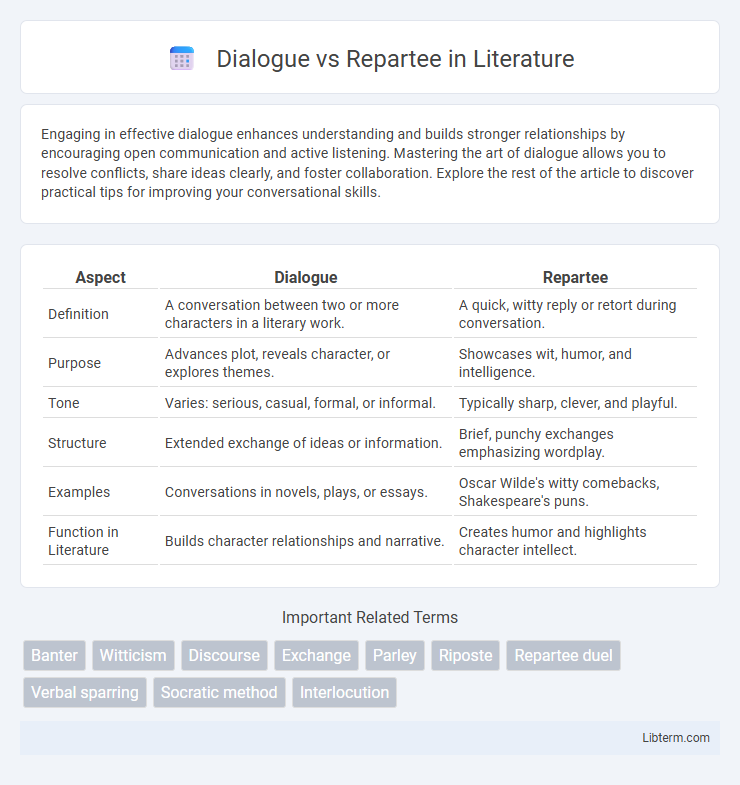Engaging in effective dialogue enhances understanding and builds stronger relationships by encouraging open communication and active listening. Mastering the art of dialogue allows you to resolve conflicts, share ideas clearly, and foster collaboration. Explore the rest of the article to discover practical tips for improving your conversational skills.
Table of Comparison
| Aspect | Dialogue | Repartee |
|---|---|---|
| Definition | A conversation between two or more characters in a literary work. | A quick, witty reply or retort during conversation. |
| Purpose | Advances plot, reveals character, or explores themes. | Showcases wit, humor, and intelligence. |
| Tone | Varies: serious, casual, formal, or informal. | Typically sharp, clever, and playful. |
| Structure | Extended exchange of ideas or information. | Brief, punchy exchanges emphasizing wordplay. |
| Examples | Conversations in novels, plays, or essays. | Oscar Wilde's witty comebacks, Shakespeare's puns. |
| Function in Literature | Builds character relationships and narrative. | Creates humor and highlights character intellect. |
Understanding Dialogue: Definition and Purpose
Dialogue is a communicative exchange between two or more participants aimed at sharing information, exploring ideas, or resolving issues, characterized by continuous, thoughtful interaction. Its purpose is to foster understanding, build relationships, and facilitate collaborative problem-solving through active listening and meaningful responses. Unlike repartee, which emphasizes quick, witty exchanges, dialogue prioritizes depth and clarity to achieve mutual comprehension.
What Is Repartee? Key Characteristics
Repartee is a swift, witty, and sharp form of verbal exchange characterized by quick comebacks and clever responses that showcase intelligence and humor. It often involves spontaneous, concise remarks that surprise or amuse, highlighting the speaker's linguistic agility and social finesse. Unlike extended dialogue, repartee thrives on brevity, timing, and the art of turning words into playful or pointed remarks within moments.
Historical Origins: Dialogue and Repartee in Literature
Dialogue finds its historical origins in ancient Greek philosophy and drama, prominently featured in Plato's Socratic dialogues where structured conversational exchange explores complex ideas. Repartee, rooted in the quick-witted verbal sparring of Renaissance courtly banter and Elizabethan theatre, gained prominence through Shakespeare's plays, showcasing clever, spontaneous retorts that highlight character intelligence and social dynamics. Both dialogue and repartee evolved as essential literary devices to reveal character psychology, advance plot, and engage audiences in various historical and cultural contexts.
Structural Differences: Dialogue vs Repartee
Dialogue typically involves an extended exchange of ideas and detailed conversation between two or more participants, emphasizing coherence and thematic development. Repartee, by contrast, is characterized by quick, witty, and often spontaneous remarks that rely on brevity and sharpness rather than sustained discussion. Structurally, dialogue unfolds progressively with complete sentences and turns, while repartee consists of rapid-fire, concise retorts designed to entertain or challenge.
Crafting Natural Dialogue: Techniques and Tips
Crafting natural dialogue requires understanding the distinction between dialogue and repartee, where dialogue builds character depth and context, while repartee emphasizes quick, witty exchanges. Techniques such as using subtext, varying sentence length, and incorporating realistic speech patterns enhance authenticity and maintain reader engagement. Employing specific character voices and emotional beats ensures conversations feel organic and contribute to narrative progression.
The Art of Repartee: Wit and Timing
Repartee showcases the art of quick wit and impeccable timing, often flourishing in conversational exchanges where sharp, clever responses illuminate social intelligence. Mastery of repartee relies on agility of mind and an acute sense of context, enabling spontaneous and pointed remarks that captivate audiences. This skill transforms ordinary dialogue into lively interactions, enhancing communication through humor and intellectual engagement.
Dialogue in Character Development
Dialogue serves as a crucial tool in character development by revealing personality traits, motivations, and emotional states through natural speech patterns and interactions. It allows writers to subtly showcase internal conflicts and growth by crafting exchanges that reflect changing relationships and evolving perspectives. Well-constructed dialogue deepens reader engagement by providing authentic voices that distinguish characters and enhance narrative depth.
Repartee’s Role in Humor and Conflict
Repartee plays a crucial role in humor and conflict by delivering quick-witted, sharp exchanges that defuse tension or provoke laughter through clever wordplay and timing. Unlike dialogue, which facilitates open communication and understanding, repartee emphasizes agility of mind to outsmart opponents or lighten serious moments. Its effectiveness relies on brevity and spontaneity, making it a powerful tool for both comedic relief and strategic verbal confrontation.
Dialogue vs Repartee in Popular Media
Dialogue in popular media serves as a tool for character development and plot progression, often revealing motivations and emotions through extended conversations. Repartee distinguishes itself by its quick, witty exchanges that showcase characters' intelligence and humor, frequently heightening tension or delivering comic relief in films, TV shows, and theater. While dialogue builds context and depth, repartee captivates audiences with sharp, memorable verbal sparring that defines iconic scenes and personalities.
Choosing the Right Approach: Context and Audience
Dialogue fosters open communication and deepens understanding through thoughtful exchange, making it ideal for collaborative settings or complex discussions. Repartee, characterized by quick wit and sharp responses, suits social or competitive environments where humor and brevity engage the audience. Selecting between dialogue and repartee depends on context and audience preferences, ensuring effective interaction tailored to the situation.
Dialogue Infographic

 libterm.com
libterm.com